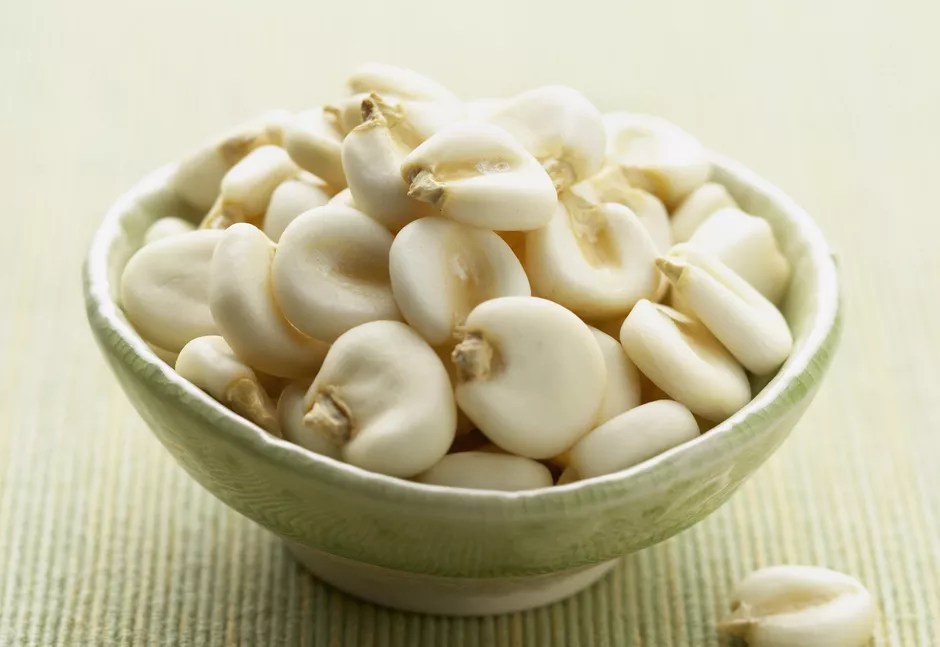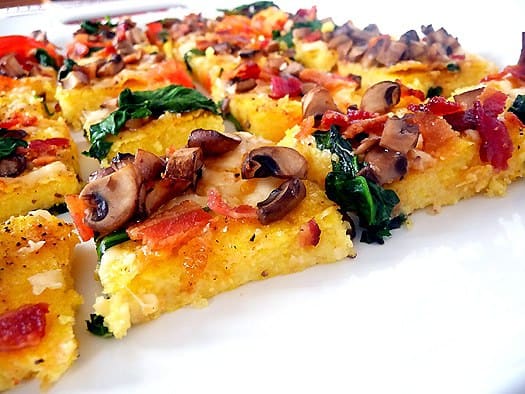
If you have seen my Theme Reveal for the A2Z Challenge 2022, then you will know that I am writing about becoming Vegetarian gradually as a response to the crisis in food supply chains sparked by the pandemic and made worse by the WAR in Ukraine. As well, I am keeping to the theme I originally planned of food which can be eaten in its own right as well as becoming an ingredient in other dishes…

Every A2Z Challenge has it’s difficult letters and for me, H is one of those! After resorting to searching Google and combing through a list of 52 foods beginning with H, I decided to go with Hominy and some seemingly similar products like cornmeal and Semolina. To connect with the other theme of this blog, these are products you might find in a Healthfood Shop, depending on where you live in the world – so what’s all that about?
To explain what hominy is – I quote from Wikipedia the fount of all knowledge (which I do contribute to each year) “Hominy is made in a process called nixtamalization. To make hominy, field corn (maize) grain is dried, and then treated by soaking and cooking the mature (hard) grain in a dilute solution of lye (potassium hydroxide) […] soaking the corn in lye[4] kills the seed’s germ, which keeps it from sprouting while in storage. Finally, in addition to providing a source of dietary calcium, the lye or lime reacts with the corn so that the nutrient niacin can be assimilated by the digestive tract.” Plus this jewel of scientific jargon – “Some of the corn oil breaks down into emulsifying agents (monoglycerides and diglycerides), and facilitates bonding the corn proteins to each other. The divalent calcium in lime acts as a cross-linking agent for protein and polysaccharide acidic side chains. Cornmeal from untreated ground corn cannot form a dough with the addition of water, but the chemical changes in masa (aka masa nixtamalera) make dough formation possible, for tortillas and other food.”
So, this Mexican speciality is quite different from Cornmeal – a staple carbohydrate in many countries around the world because of the treatment with Lye that makes it both able to form a dough as well as being more nutritious with the ability to provide Niacin and some extra Calcium. Both products are ground to various sizes of particles, right down to flour, but it’s interesting that only one country has discovered the secret of nixtamalization (how much could you score in Scrabble for that?) and can make true dough-based dishes. This article gives some recipes since I confess to never having tried hominy and only having vaguely heard of Hominy Grits.
On the other hand, I am familiar with Cornmeal – or Polenta and sometimes use it to make a quick pseudo-pizza, because who has time to make a yeasted dough, prove it, spin it round in the air to spin a disk and then top and bake it!
Frewin’s Pseudo Pizza
1. Add cornmeal – anything from fine to coarse, to a saucepan of boiling salted water. I judge the amount by pouring it carefully into the centre to form a cone whose top reaches the surface of the water.
2. stir frequently until the mixture sets like a thick custard and then pour out onto a wooden cutting or breadboard.
If you have any leftovers, then the next day, cut into cubes and shallow fry till heated through and crisp on the bottom…

I turn to Semolina because it is also a versatile grainy looking substance which I for one, often think of in the same usage category as cornmeal but which in fact, is made from our old friend wheat. Most semolina is made from hard Durum wheat – the same one that is used to make pasta but if made from softer wheat it is known as Farina and softer and stickier. When I was growing up, Semolina Pudding was a frequent dish but has been crowded out by the plethora of more elaborate confections on offer today. What is interesting to compare with hominy, is how a similar problem is solved by a more physical process. All grains have a husk or bran outer layer. Inside wheat are two halves of the part which is ground into flour, the endosperm or middings, and between these, nestles the wheatgerm, a tiny plant in the making, ready to be activated by moisture. If you stonegrind wheat, this little plant gets mashed up in the flour and will cause the flour to spoil fairly quickly (so don’t let stoneground flour linger in your cupboards) and the same is true of corn. Hominy solves this problem by chemically treating the kernels of corn which kills the little plant and softens the husk allowing it to be removed. With wheat, it is nowadays ground in roller mills – heavy metal rollers that are set apart so precisely, that they first crack the husk off, secondly break the two halves of the endosperm apart simultaneously allowing the wheatgerm to fall away, and thirdly, they can produce flour of different quality as they gradually and precisely grind the endosperm ever smaller. Semolina is produced by breaking the endosperm up into pieces rather than flour, once the bran and wheatgerm have been cracked off. Incidentally – they can toast the wheatgerm to kill it, then add it back into the ground bran and flour to produce 100% Wholewheat flour, but unlike stoneground flour, where the carbohydrate is released slowly into your body, such wholewheat flour is basically fast release white flour albeit with added fibre and some vitamins from the wheatgerm. Slow food is better – more of that later…
If you have to choose between Hominy and Cornmeal, then remember that Hominy has a little extra calcium and allows you to digest Niacin, a form of vitamin B – so especially beneficial to vegans, which segues nicely into Healthfood Stores.
Many are confused between Healthfood and Wholefood Stores – they are both about healthy food – right? Well, up to a point, because their philosophy is completely different. Healthfood shops are usually half devoted to supplements – pills in the main, which are to make up for deficiencies in the modern diet. The other half is usually dry goods which are regarded as healthy and perhaps some of the more difficult to source in the supermarkets. These dry goods are also usually available in Wholefood Stores, but often at a much better price and the philosophy is quite opposite – eat whole (unprocessed) foods and you won’t need all the supplements. Well that’s not altogether true – modern science has given us an understanding of conditions that require additional supplements to that found just in the diet – true this may be because food quality is not the best – and here the Wholefood Store tries to provide the best in Organic quality foods, but let’s face it, we cannot all afford the prices of such quality food and supplements may be a cheaper option. Its hard to find an affordable balance between the two philosophies, but understanding the difference between them is a good starting point…
What kind of food do you eat, healthfood, wholefood, convenience, ethnic, affordable? The choices are only going to become more difficult in the next while following the war in Ukraine – source of much wheat, but also other grains like millet and bulgar.
Your recipe looks good!
I imagine you have cornmeal in India though I have never seen it on menus…
Thanks Frédérique
Oh wow nixtamilization…hominy…i am learning so much by coming here. Never heard of them! Your pseudo pizza recipe seems grt
I have never eaten Hominy, but I do know what it is because I watch Tasting History with Max Miller on YouTube, and he has mentioned it several times. I am not sure where I would be able to get it round our way.
My fav pizza dough is a throw it together, then leave it in the fridge over night yeasted dough – no kneading required. Of course the only thing is remembering to make it the day before 🤣. I also tried a cauliflower base for pizza once, and cauli garlic “bread” – they were both good, but def not pizza or garlic bread 🤣. Polenta is an interesting one to try – thank you for the recipe.
Tasha
Tasha’s Thinkings: YouTube – What They Don’t Tell You (and free fiction)
Thanks for visiting – yes Cauliflower is a bit of a wunder-veg – especially at the moment – have you tried Cauliflower Steaks?
We love cornbread made with cornmeal. There is also a pizza that we’ve purchased at Sprouts with a cornmeal crust. We love grits. I have never purchased hominy but I remember my mom serving it a few times when I was a child. It was cooked – maybe in water/broth and a little butter perhaps.
I looked up Hominy on google shopping and found that many of the Asian stores near me do sell it so I will give it a go…
Yes hominy is a style I’ve eaten in cornbread and grits. I’ve still yet to actually try polenta, but everyone says it is so good.